Konstantin Korovin
| Konstantin Korovin | |
|---|---|
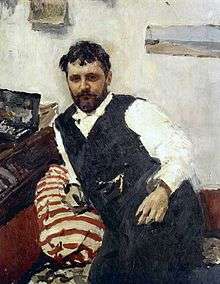 Valentin Serov, Portrait of Konstantin Korovin, 1891 | |
| Born |
5 December [O.S. 23 November] 1861 Moscow, Russian Empire |
| Died |
11 September 1939 (aged 77) Paris, France |
| Nationality | Russian |
| Education | Moscow School of Painting, Sculpture and Architecture |
| Known for | Painting |
| Notable work |
Hammerfest: Aurora Borealis 1894–1895 Portrait of Feodor Chaliapin 1915 |
| Movement | Impressionism |
| Awards | Legion of Honour |
Konstantin Alekseyevich Korovin (Russian: Константи́н Алексе́евич Коро́вин, first name often spelled Constantin; 5 December [O.S. 23 November] 1861 – 11 September 1939) was a leading Russian Impressionist painter.
Biography
Youth and education
Konstantin was born in Moscow to a merchant family officially registered as "peasants of Vladimir Gubernia". His father, Aleksey Mikhailovich Korovin, earned a university degree and was more interested in arts and music than in the family business established by Konstantin's grandfather. Konstantin's older brother Sergei Korovin was a notable realist painter. Konstantin's relative Illarion Pryanishnikov was also a prominent painter of the time and a teacher at the Moscow School of Painting, Sculpture and Architecture.
In 1875 Korovin entered the Moscow School of Painting, Sculpture and Architecture, where he studied with Vasily Perov and Alexei Savrasov. His brother Sergei was already a student at the school. During their student years, the Korovins became friends with fellow students Valentin Serov and Isaac Levitan; Konstantin maintained these friendships throughout his life.
In 1881–1882, Korovin spent a year at the Imperial Academy of Arts in St. Petersburg, but returned disappointed to the Moscow School of Painting, Sculpture and Architecture. He studied at the school under his new teacher Vasily Polenov until 1886.
In 1885 Korovin traveled to Paris and Spain. "Paris was a shock for me … Impressionists… in them I found everything I was scolded for back home in Moscow", he later wrote.
Early works

Polenov introduced Korovin to Savva Mamontov's Abramtsevo Circle: Viktor Vasnetsov, Apollinary Vasnetsov, Ilya Repin, Mark Antokolsky and others. The group's love for stylized Russian themes is reflected in Korovin's picture A Northern Idyll. In 1885 Korovin worked for Mamontov's opera house, designing the stage decor for Giuseppe Verdi's Aida, Léo Delibes' Lakmé and Georges Bizet's Carmen.
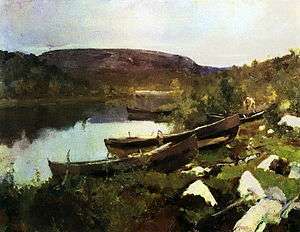
In 1888 Korovin traveled with Mamontov to Italy and Spain, where he produced the painting On the Balcony, Spanish Women Leonora and Ampara. Konstantin traveled within Russia, the Caucasus and Central Asia and exhibited with the Peredvizhniki. He painted in the Impressionist, and later in the Art Nouveau, styles.
In the 1890s Korovin became a member of the Mir iskusstva art group.
Korovin's subsequent works were strongly influenced by his travels to the north. In 1888 he was captivated by the stern northern landscapes seen in The Coast of Norway and the Northern Sea.
His second trip to the north, with Valentin Serov in 1894, coincided with the construction of the Northern Railway. Korovin painted a large number of landscapes: Norwegian Port, St. Triphon's Brook in Pechenga, Hammerfest: Aurora Borealis, The Coast at Murmansk and others. The paintings are built on a delicate web of shades of grey. The etude style of these works was typical for Korovin's art of the 1890s.
Using material from his trip, Korovin designed the Far North pavilion at the 1896 All Russia Exhibition in Nizhny Novgorod. He painted ten big canvasses for the pavilion as well, depicting various aspects of life in the northern and Arctic regions. After the closure of the Exhibition, the canvasses were eventually placed in the Yaroslavsky Rail Terminal in Moscow. In the 1960s, they were restored and transferred to the Tretyakov Gallery.[1]
In 1900 Korovin designed the Central Asia section of the Russian Empire pavilion at the Paris World Fair and was awarded the Legion of Honour by the French government.
In the beginning of the 20th century, Korovin focused his attention on the theater. He moved from Mamontov's opera to the Mariinsky Theatre in St. Petersburg. Departing from traditional stage decor, which only indicated the place of action, Korovin produced a mood decor conveying the general emotions of the performance. Korovin designed sets for Konstantin Stanislavsky's dramatic productions, as well as Mariinsky's operas and ballets. He did the stage design for such Mariinsky productions as Faust (1899), The Little Humpbacked Horse (1901), and Sadko (1906) that became famous for their expressiveness.
In 1905 Korovin became an Academician of Painting and in 1909–1913 a professor at the Moscow School of Painting, Sculpture and Architecture.
One of the artist's favourite themes was Paris. He painted A Paris Cafe (1890s), Cafe de la Paix (1905), La Place de la Bastille (1906), Paris at Night, Le Boulevard Italien (1908), Night Carnival (1901), Paris in the Evening (1907), and others.
During World War I Korovin worked as a camouflage consultant at the headquarters of one of the Russian armies and was often seen on the front lines. After the October Revolution Korovin continued to work in the theater, designing stages for Richard Wagner's Die Walküre and Siegfried, as well as Pyotr Ilyich Tchaikovsky's The Nutcracker (1918–1920).
In 1923 Korovin moved to Paris on the advice of Commissar of Education Anatoly Lunacharsky to cure his heart condition and help his handicapped son. There was supposed to be a large exhibition of Korovin's works, but the works were stolen and Korovin was left penniless. For years, he produced the numerous Russian Winters and Paris Boulevards just to make ends meet.
In the last years of his life he produced stage designs for many of the major theatres of Europe, America, Asia and Australia, the most famous of which is his scenery for the Turin Opera House's production of Nikolai Rimsky-Korsakov's The Golden Cockerel.
Korovin died in Paris on 11 September 1939.
Konstantin's son Alexey Korovin (1897–1950) was a notable Russian-French painter. Because of an accident during his childhood he had both feet amputated. Alexey committed suicide in 1950.
Works
 Twilight in a Room. 1880s
Twilight in a Room. 1880s- Hammerfest: Aurora Borealis. 1894–1895
- Arkhangelsk Port on the Dvina. 1894
 Parisian Cafe. Late 1890s
Parisian Cafe. Late 1890s- Paris. Café de la Paix. 1906
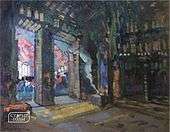 Theatrical Composition. 1910s
Theatrical Composition. 1910s Two Ladies on a Terrace. 1911
Two Ladies on a Terrace. 1911- Moonlit Night, Winter. 1913
- Pier in Gurzuf. 1914
 Dmitry Donskoy, WWI poster. 1914
Dmitry Donskoy, WWI poster. 1914 Lilac. 1915
Lilac. 1915 Feodor Chaliapin. 1915
Feodor Chaliapin. 1915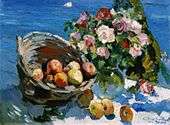 Gurzuf. 1916
Gurzuf. 1916- Spring. 1917
 Moonlit Night. Paris. 1929
Moonlit Night. Paris. 1929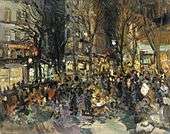 Parisian Street Scene
Parisian Street Scene Paris. 1933
Paris. 1933- Paris, Arch of Saint Denis. 1930s
 Costume design for Prince Igor
Costume design for Prince Igor
References
- ↑ Чурак, Г. С. (2012). Монументально-декоративные панно Константина Коровина (in Russian). Moscow: Tretyakov Gallery. pp. 259–289. ISBN 978-5-4350-0020-7.
External links
| Wikimedia Commons has media related to Konstantin Korovin. |
- Konstantin Korovin Personal Website. Biography, photos, articles, complete art gallery, etc.
- Online Korovin Gallery
- Korovin's biography
- Korovin gallery (Russian)
- Konstantin Korovin paintings & interactive timeline
